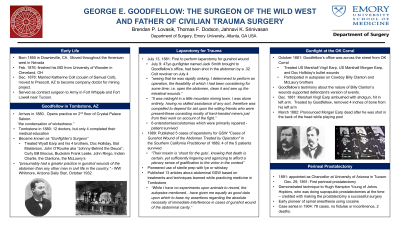General Surgery
Category: Quickshot Oral Session 04
Quickshot Oral : Quickshot Oral Session 04
GEORGE E. GOODFELLOW: THE SURGEON OF THE WILD WEST AND FATHER OF CIVILIAN TRAUMA SURGERY
Saturday, February 11, 2023
3:00pm - 4:00pm East Coast USA Time

- BL
Brendan P. Lovasik, MD
Resident
Emory University , Georgia, United States - BL
Brendan P. Lovasik, MD
Resident
Emory University , Georgia, United States
Presenter(s)
Principal Contact(s)
Objectives: In this historical retrospective, we review the life and contributions of George E. Goodfellow, a surgeon in the “Wild West” whose experience with gunshots and penetrating trauma were a key part of American surgical history. Born in 1855 in Downieville, CA, he spent much of his early life moving throughout the western US. In 1876 he completed medical school at University of Wooster (Cleveland, OH) before becoming the company doctor to a mining project in Prescott, AZ. He also served as the surgeon to Fort Whipple, where he narrowly missed an assignment to work with Custer’s brigade at Little Big Horn. He arrived in Tombstone, AZ in 1880, where he became known as the “Gunfighter’s Surgeon” by treating Wyatt Earp and his brothers, Doc Holliday, and Bat Masterson, among others. It was said that Goodfellow “presumably had a greater practice in gunshot wounds of the abdomen than any other man in civil life in the country.” In 1881, Goodfellow was the first in the US to perform a laparotomy for a gunshot wound, as standard of care at the time was tractotomy / probing. Goodfellow served as a medical expert in the hearings of the Gunfight at the OK Corral, in addition to treating the Earp brothers. He moved to Tucson in 1884, and in 1891 where he was the first to perform perineal prostatectomy – by 1904, Goodfellow had performed nearly 75 prostatectomies with no postoperative fistulae or incontinence. Goodfellow serves an interesting surgical career as a pioneer in trauma laparotomy, the “Father of Civilian Trauma Surgery”, innovator of successful approach for prostatectomy, and living a colorful life as surgeon in the American West.
Methods:
Results:
Conclusion:
Methods:
Results:
Conclusion:

